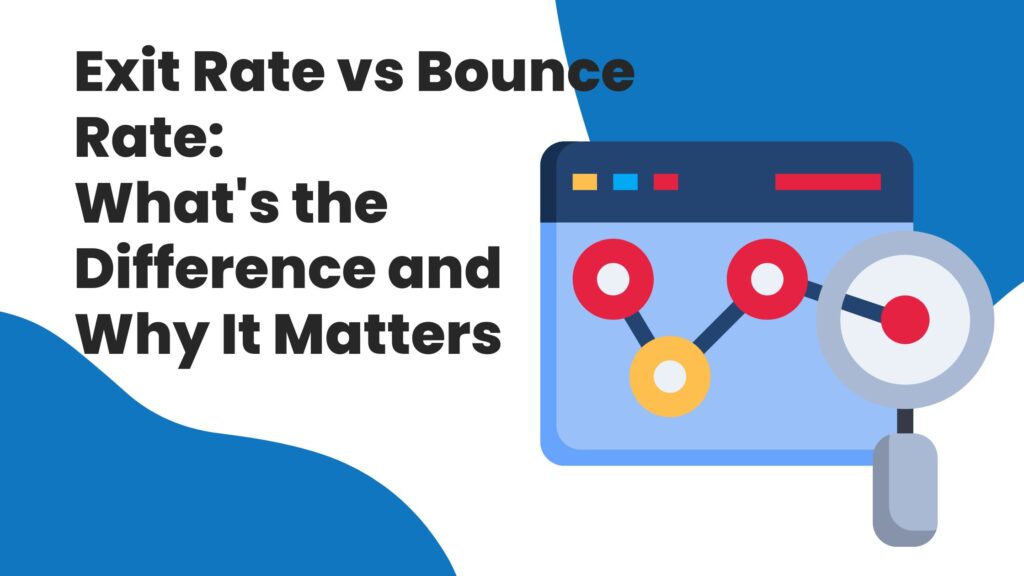Welcome to the world of digital marketing, where analytics and data are essential to success. As a business owner, you want to make sure your website is working optimally, but with so many different phrases and concepts to learn, it can be difficult to know where to begin. Exit rate and bounce rate or as some consider it, exit rate vs bounce rate, are two indicators that frequently generate confusion. While they may appear to be the same, they are not and might have various effects on the effectiveness of your website, hence the blog title Exit Rate vs Bounce Rate. In this blog, we’ll look at the distinctions between exit rate and bounce rate, why they matter, and how you can utilise them to improve the performance of your website.
Before I move on I wanted to also add a quick tip. To keep people on your website longer, make sure you’re content is the best it can be. To get help read more about creating content with Chat GPT as your writing assistant, and make sure it can easily be navigated.

Understanding Exit Rate
Definition and Calculation of Exit Rate
Before we get onto exit rate vs bounce rate, lets break them down individually so you can better understand what each does. Exit rate is a metric that calculates the percentage of website users who exit after seeing a certain page. Exit rate, as opposed to bounce rate, which records the number of visitors who leave your website after just viewing one page, tracks the number of visitors that leave after visiting any page on your website. The exit rate is derived by dividing the total number of pageviews by the number of departures from a certain page.
Examples of When Exit Rate Matters
Exit rate is an important measure to monitor since it can suggest issues with your website. For example, a high exit rate on a checkout page may indicate that visitors are having difficulty completing their purchases. Similarly, a high exit rate on a blog post may suggest that readers do not find the information interesting enough to keep browsing your website.
Ways to Improve Exit Rate
To increase the departure rate of your website, you must first understand why people are leaving in the first place. Here are some ideas for lowering your website’s exit rate:
Optimise Page Load Time: Slow-loading pages can frustrate visitors and cause them to abandon your website. To boost page speed, optimise your website’s photos and limit the number of plugins.
Simplify Navigation: Simplify your website’s navigation to make it easier for visitors to find what they’re looking for. Avoid utilising too many submenus and use clear and simple labels for each menu item.
Optimise Content: Make sure the material on your website is relevant and entertaining. To break up the language and make it more legible, use clear headings and subheadings, bullet points, and graphics.
Provide a Clear CTA: Motivate visitors to take action by including a clear CTA on each page. A clear call-to-action can assist lower exit rates, whether it’s to make a purchase, sign up for a newsletter, or contact you for further information.
By improving your website’s exit rate, you can improve the overall user experience and increase engagement with your brand.

Understanding Bounce Rate
Definition and Calculation of Bounce Rate
The percentage of visitors who leave your website after only reading one page is referred to as the bounce rate. A “bounce” happens when a visitor comes to your website, examines only one page, and then leaves without taking any further action. The bounce rate is derived by dividing the total number of visitors to your website by the number of bounces.
Examples of When Bounce Rate Matters
Bounce rate is an important indicator to monitor since it can identify issues with your website. For example, a high bounce rate on your homepage may indicate that visitors are unable to discover the information they require or that your website’s design is unappealing. Similarly, a high bounce rate on a product page could suggest that visitors are dissatisfied with the product information or cost.
Ways to Improve Bounce Rate
To reduce your website’s bounce rate, you must first understand why users leave after only viewing one page. These are some ideas for lowering your website’s bounce rate:
Improve Page Load Time: Slow-loading pages can cause frustration and lead visitors to abandon your website. Optimise your website’s images and reduce the number of plugins to improve page speed.
Simplify Navigation: Make it easy for visitors to find what they are looking for by simplifying your website’s navigation. Use clear and concise labels for each menu item and avoid using too many submenus.
Create Relevant Content: Ensure that your website’s content is relevant and engaging. Use clear headings and subheadings, bullet points, and images to break up the text and make it more readable.
Optimise Landing Pages: Landing pages are designed to encourage visitors to take action, whether it’s to make a purchase, sign up for a newsletter, or download a resource. By optimising your landing pages, you can reduce bounce rates and increase conversions.
By improving your website’s bounce rate, you can increase the chances of visitors exploring more pages on your website and engaging with your brand.

Comparing Exit Rate vs Bounce Rate
Key Differences Between the Two Metrics
Ok, that’s the breakdown now lets get onto exit rate vs bounce rate and what’s the competition all about. While the terms exit rate and bounce rate are frequently used interchangeably, they are two separate metrics that assess different aspects of website performance. Bounce rate is the percentage of visitors that leave your website after reading only one page, whereas exit rate is the percentage of visitors who leave after viewing any page. In other words, the bounce rate counts the number of single-page sessions, and the exit rate counts the number of page exits.
How to Interpret Exit Rate and Bounce Rate Data
Exit rate and bounce rate data interpretation might assist you in identifying issue spots on your website. A high bounce rate on a given page may indicate that visitors do not find the material interesting enough to continue browsing your website, whilst a high exit rate may indicate that visitors are having problems with a specific page.
Using Both Metrics to Identify Website Performance Issues
You can pinpoint certain pages on your website that are generating problems for users by analysing exit rate and bounce rate data. For example, if a product page has a high bounce rate and a high exit rate, it may indicate that visitors are not finding the product information they require to complete a purchase. If, on the other hand, you have a high bounce rate but a low exit rate on a blog post, it may indicate that visitors find the material intriguing but are not investigating other pages on your website.

Why Exit Rate and Bounce Rate Matter
Impact of High Exit Rate and Bounce Rate on Website Success
High exit and bounce rates might have a detrimental impact on the success of your website. A high bounce rate may indicate that visitors do not find your website’s content entertaining or relevant, whereas a high departure rate may indicate that visitors are having problems or are frustrated. These KPIs can contribute to poorer engagement, conversions, and, eventually, income for your company.
Role of Exit Rate and Bounce Rate in Search Engine Rankings
Exit and bounce rates might also have an effect on your website’s search engine rankings. While calculating search ranks, search engines such as Google take user engagement measures into account. A high bounce rate and departure rate could signal to search engines that your website’s content is neither relevant or interesting, resulting in lower search ranks.
How to Use Exit Rate and Bounce Rate to Improve Website Engagement
You may find areas for improvement on your website and make changes to boost interaction by using exit rate and bounce rate statistics. For example, if a given page has a high bounce rate, you may want to check the content and ensure it is relevant to the search terms driving people to that page. Alternatively, if a checkout page has a high exit rate, you may want to simplify the checkout process or address any technical concerns.
Exit and bounce rate data can also be used to evaluate other techniques for increasing engagement, such as different page layouts or calls-to-action. By continuously monitoring and improving these indicators, you can increase engagement, decrease bounce and exit rates, and eventually grow your online presence.
Finally, departure and bounce rates are critical indicators for gauging website engagement and finding areas for development. Understanding the impact of these indicators on your website’s success and search engine rankings, and using the data to make improvements, can allow you to enhance engagement, decrease bounce and exit rates, and, eventually, grow your online presence.
Recap of Key Points
In this exit rate vs bounce rate blog post, we discussed the differences between exit rate and bounce rate, why they matter, and how to utilise them to improve the performance of your website. The following are the important takeaways:
- Exit rate measures the percentage of visitors who leave your website after viewing a specific page, while bounce rate measures the percentage of visitors who leave your website after only viewing one page.
- High exit and bounce rates can impact your website’s success, search engine rankings, and revenue.
- By using exit rate and bounce rate data, you can identify areas for improvement on your website and make changes to improve engagement.
As a business owner, you must understand the metrics that influence the success of your website. You can gain insights into how visitors interact with your website and make changes to improve engagement by using exit rate and bounce rate data. I recommend that you monitor these data on a regular basis and use the information to improve the performance of your website.
Digital marketing is a constantly evolving landscape, and it’s important to stay up-to-date on the latest metrics and trends. By regularly monitoring your website’s performance and staying informed on new developments, you can stay ahead of the competition and continue to grow your online presence.
Thank you for reading this blog post and wanting to understand morea around exit rate vs bounce rate. I hope you found it informative and helpful in improving your website’s performance. If you want to read more on exit rate vs bouce rate you can do so on Googles own website.

